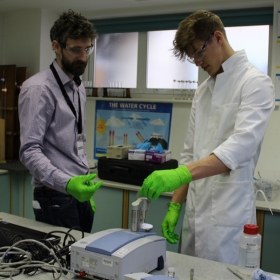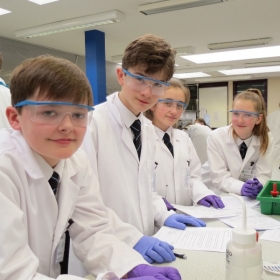Students experience real-life Chemistry in action
Published on isbi School News dated Friday 1st of June 2018
Two events on the same day brought Chemistry students’ laboratory work to life by showing the real world application of theories and skills they have mastered in lessons. Four Second Year pupils represented the School at Salter’s Festival of Chemistry at the University of York, while A Level students used a University of Bradford spectrometer to inspect the purity of samples they had created in the School laboratories. Pocklington School Second Year Students at Salter's Festival of ChemistrySecond Years Kate Scott-Clappison, Zac Stewart, Will Jones and Eve Levitt competed against other local schools in the Salter’s Festival, which involved using their knowledge of Chemistry to solve two enjoyable challenges. They then listened to a lecture about colour; how fireworks relate to chemistry and how bioluminescence works. They also had a look at different acidities and alkalis and how they react with different indicators. Kate said: “Overall we had a great day and I think we did well. We were very close to a competition prize but sadly did not quite reach our target.” Meanwhile, the practical skills of Pocklington School A Level students were put to the test when the Royal Society of Chemistry sent an expert from the University of Bradford to help them test the purity of aspirins they had synthesised in lessons. Students experience real-life Chemistry in actionJames Machell brought an Infrared spectrometer to inspect their results, as part of the Royal Society-supported Spectroscopy in a Suitcase scheme. The scientific measurement technique records how molecules respond to infrared light, and each student used it to analyse their aspirin sample. Tiny traces of other substances were identified, showing an average 50% purity. IR spectroscopy has a wide range of applications in both research chemistry and wider society. It’s used to help identify the structure of complex molecules in space, to analyse works of art and in Formula 1 motor racing. Many breathalysers used by police forces to determine levels of alcohol in breath are IR spectrometers. James also brought a powerful NMR (nuclear magnetic resonance spectroscopy) machine with him to the School chemistry labs. He showed students how it works and discussed its use in chemical research at the University. The NMR is used to determine how proteins fold, twist and coil, and to evaluate the proportions of solid and liquid components in fatty foodstuffs such as margarines and low-fat spreads. NMR is also used a lot in pharmaceutical sciences and medicine, for example: the diagnosis of tissue abnormalities and body scanning by magnetic resonance imaging (MRI). Jenny McDowell, Head of Chemistry, said: “Both experiences were most enjoyable and valuable for our Chemistry students. The Second Year team did tremendously well and learned a great deal, and our Upper Sixth students were able to appreciate the important use of the spectroscopy equipment in research, medicine and other areas to benefit our lives.”


